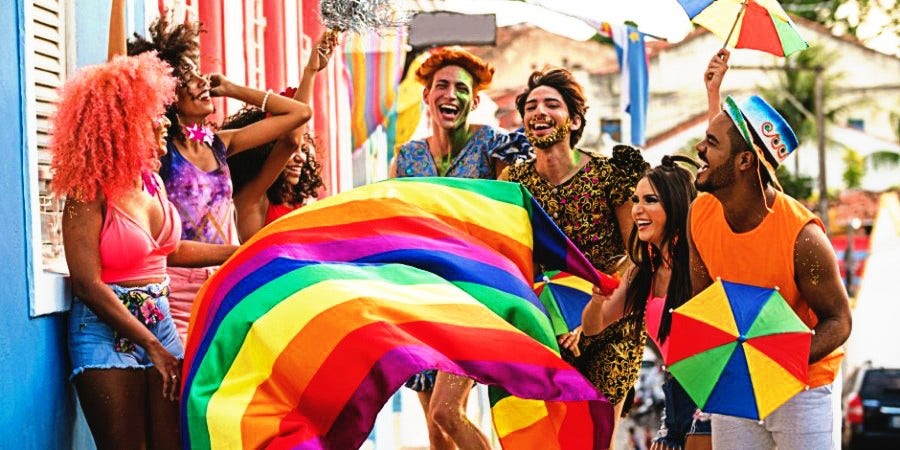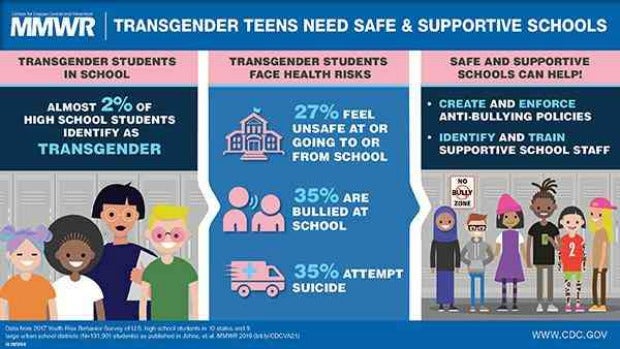The Problematic Nature Of Pride Month 'Merch' You Probably Haven't Thought Of (But Seriously Should)
What's missing from this picture?
 Getty
Getty On June 28, 1970, the first "Gay Pride March" stretched through Midtown Manhattan in a sign of ;solidarity on the first anniversary of the Stonewall Riots.
In the decades that followed, the LGBTQIA+ (lesbian, gay, bisexual, transgender, queer or questioning, intersex, and asexual or allied) community expanded their efforts to bring attention to the fight for LGBT rights, establishing June as Pride Month.
And now, every June, corporations scramble to get on the Pride bandwagon with marketing and advertising campaigns selling "merch" aimed at the LGBTQIA+ community.
Each year, we see more and more brands, including large Fortune 500 companies, taking advantage of Pride Month to advertise their products to our community and allies.
For example, SKYY Vodka, which has a long history saucing up the LGBTQIA community, is the official sponsor of many Pride 2019 festivals around the country.
As reported in Forbes, SKYY's "new campaign, 'Proudly American,' debuted during LGBT Pride Month. The first installment of the yearlong campaign, titled 'Home of the Brave,' ;features billboards, ads and short videos with gay artists and athletes. Drag artists Trixie Mattel and Dusty Ray Bottoms as well as Olympic silver medalist Gus Kenworthy are among the faces showcased."
Facebook and Twitter feeds are awash in rainbows, YouTube created a special video titled "#ProudToLove - Celebrating Marriage Equality and LGBT Pride Month", and everyone from Teva, with their flatform universal pride sandals, to Disney, with their New Disney Rainbow Collection, has already begun peddling special goods in the hope of earning a few (billion) extra bucks.
Sure, many of these businesses do mean well.
But when it comes to major corporate sponsors (see New York City’s Pride sponsorship list), the financial support seems ironic at best, as Evan Greer, Deputy Director of Fight For The Future, points out in this powerful Twitter thread:
While these corporations are sweeping in cash, the LGBTQIA community struggles with disproportionately higher levels of poverty compared to heterosexual individuals.
Results of a 2016 study show that one in four LGBTQIA individuals didn’t have enough money to feed themselves or their families during some period of the previous year; that’s approximately 2.4 million people.
The same study noted that, in comparison with cisgender folks, transgender individuals are four times more likely to have an annual income of $10,000 or less — well below the poverty line in the continental United States, which is set at $12,140 per year for a household composed of one person.
The more corporations seem to benefit from marketing to our community, the further we seem to drift from celebrating the true meaning of Pride Month and it's history, which evolved from Gay Pride to the current, more inclusive, Pride movement.
Pride month is, after all, a lot more than parades and rainbow t-shirts. It's about resistance.
The month of June was specifically chosen in commemoration of the Stonewall Riots.
As explained by Wikipedia, "The Stonewall Riots (also referred to as the Stonewall uprising or the Stonewall rebellion) were a series of spontaneous, violent demonstrations by members of the gay (LGBT) community against a police raid that took place in the early morning hours of June 28, 1969, at the Stonewall Inn in the Greenwich Village neighborhood of Manhattan, New York City. They are widely considered to constitute the most important event leading to the gay liberation movement and the modern fight for LGBT rights in the United States ...
"Two Presidents of the United States have officially declared a Pride Month. First, President Bill Clinton declared June "Gay & Lesbian Pride Month" in 1999 and 2000. Then from 2009 to 2016, each year he was in office, President Barack Obama declared June LGBT Pride Month. Donald Trump became the first Republican president to acknowledge LGBT Pride Month in 2019, but he did so through tweeting rather than an official proclamation."
This year's Pride Month is the 50th anniversary of Stonewall, perhaps most meaningfully noted by the monument now being erected in New York City in commemoration of Marsha P. Johnson and Sylvia Rivera.
The two early LGBT activists were key figures in the Stonewall Upprising, and subsequently the first transgender individuals (both of whom were also women of color) to be immortalized in statues within the United States.
Where in all of these Fortune 500 companies’ Pride ad campaigns are these women celebrated, though?
Where, in all the commercials and billboards, is the acknowledgement of our great foremothers who led the way?
I came out as queer at the end of 2017. Until then, I’d lived in the closet for the first 27 years of my life.
While there were obviously a great deal of changes in my life, one of the most significant I've witnessed is the way corporations monetize my sexual orientation every June.
It’s eye-opening to be part of a community that still faces blatant discrimination, even as corporations clamor to be our supposed allies for 30 days out of the year.
For the rest of the year, queer lives aren’t exactly celebrated.
Black transgender women are killed at disproportionately high rates.
In addition, the suicide rates among queer youth are significantly higher than among the general population, at least in part due to bullying by peers and a lack of acceptance by family members.
The CDC's 2016 National Youth Risk Behavior Survey notes that suicidal behavior rates are significantly higher among gay, lesbian and bisexual students, stating: "Nationwide, 8.6% of all students; 6.4% of heterosexual students; 29.4% of gay, lesbian, and bisexual students; and 13.7% of not sure students had attempted suicide one or more times during the 12 months before the survey."
A 2017 supplementary ;report from the CDC notes that transgender youth attempt suicide at a staggering rate of 35 percent.
And results of a study publishd in American Medical Association journal JAMA Pediatrics states that youth suicidal behavior rates declined most dramatically in states that passed marriage equality laws, indicating that societal acceptance is likely to make a significant difference in the well-being of queer youth.
It's important to note, however, that even with this reduction, the relatively high risk of death by suicide for queer youth persists.

Several companies have pledged to donate a percentage of their proceeds to LGBTQIA causes this June. On the surface, this seems incredibly generous.
For example:
- H&M announced its “Stay True Stay You” collection, an advertising campaign starring actress and LGBTQIA Laverne Cox, from which 10 percent of collection’s global sales will support the United Nations’ Free and Equal campaign against homophobia and transphobia.
- Express recently launched its Love Unites Pride Campaign, from which the company "will donate 25% of the net income to GLAAD to accelerate acceptance for the LGBTQ+ community."
- The Todd Snyder X Champion Pride Collection features t-shirts, sweatpants, and shorts to commemorate the 50th anniversary of the Stonewall Riots, stating, "This limited-edition collection marks our dedication to honoring this year’s 50th anniversary of New York Pride. 20 percent of sales will go to the National Park Foundation to support the Stonewall National Monument."
Campaigns have also been announced by brands such as Bombas, Madewell, Urban Decay, and beyond.
The list is seemingly endless.
While these gestures may seem generous at face value, it’s well-known that giving back is a fantastic PR move that's great for a business’s bottom line.
And it's shouldn't go unnoticed that a donation of 10 percent means a company like H&M will be keeping 90 percent of the profits from their Pride gear collection sales.
Some companies, however, are donating 100 percent of the proceeds from sales of Pride merch to LGBTQIA non-profits.
- American Apparel: "This year, 100% of net proceeds from our [How We Love] Pride Collection will be benefit the Los Angeles LGBT Center's Trans-Cosmetic Donation Drive, founded by celebrity hairstylist Andrew Fitzsimons to serve low-income trans and gender non-conforming people."
- Fossil: "100% of proceeds from our limited-edition Pride Month watch case will benefit the Hetrick-Martin Institute," a New York City-based non-profit organization devoted to serving the needs of lesbian, gay, bisexual, transgender, or questioning (LGBTQ) youth.
- Ralph Lauren: "When you shop the Pride graphic tee, 100% of the purchase price is donated to @StonewallFoundation. When you shop the Pride hoodie, hat, tote, and Polo shirt 50% of the purchase price is donated."
- Under Armour: "All proceeds from the UA Pride collection will go towards Athlete Ally ... a nonprofit organization that works towards eliminating homophobia and transphobia in sports with curriculum designed to foster inclusive and enriching environments for all athletes."
I suppose supporting these companies is better than buying a random rainbow shirt on Amazon, where you’ll have no idea how much of your money actually goes to support LGBTQIA folks.
If you truly want to sport some Pride gear while supporting the LGBTQIA community, though, I suggest you purchase an item from a small, queer-owned business, such as NYC and LA-based Otherwild, "a studio, a store and a gathering, workshop and event space ... founded in 2012 within a vast, multi-disciplinary community of inspiring artists, craftspeople and designers" ;or online retail shop Wildfang, "started with the 'radical' belief that a womxn has the right to wear whatever the hell she wants and be whoever the hell she wants."
Every June, though, I see countless folks, including straight people, donning their best rainbow and glitter-laden gear while guzzling vodka sodas — the critical issues still facing the LGBTQIA+ community apparently out of sight and out of mind.
While I’m happy to see more and more allies every year, I can’t help but wonder if straight people attending Pride celebrations do anything to support organizations that advocate for the LGBTQIA community, such as the Human Rights Campaign.
I wonder if, instead of buying a pair of $120 rainbow sneakers, people should just donate directly to a cause instead?
The bottom line is, queer people deserve more than a month of recognition, particularly when so much of the money generated from Pride-themed collections seems to go directly into the back pockets of large corporations.
The LGBTQIA community deserves corporate policies that oppose discrimination, support comprehensive healthcare and hold corporations accountable beyond the month of June.
Corporate responsibility means supporting the disenfranchised, as well as making sure every LGBTQIA employee feels safe on the job.
Sure, significant improvements have been made for the LGBTQIA community in the past few decades. Still, there’s significant work that needs to be done to ensure the safety and equality of vulnerable individuals.
Until then, corporations should be ;supporting the LGBTQIA+ population year-round, not just during Pride Month.
Bonnie Horgos is a freelance writer based in Minneapolis, who writes about feminism, LGBTQ issues, gender-based violence, health, and wellness. For more, visit her website or follow her on Twitter.
YourTango may earn an affiliate commission if you buy something through links featured in this article.

